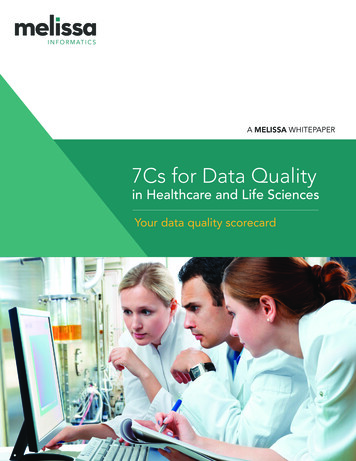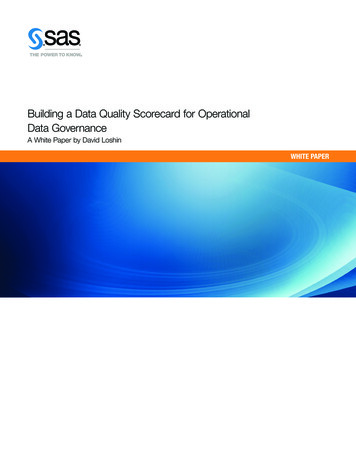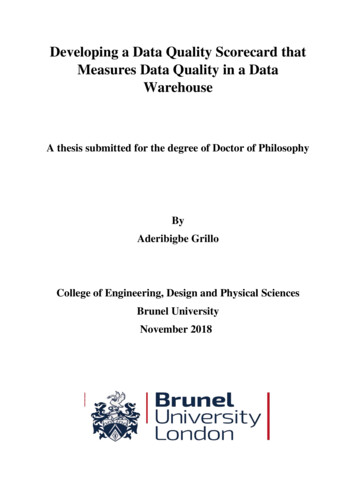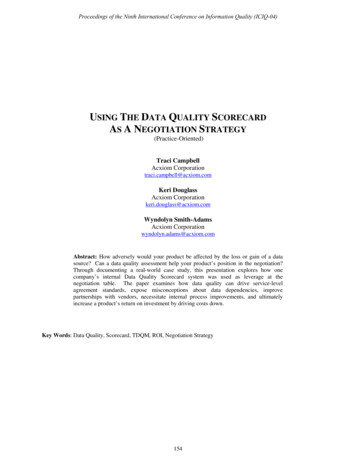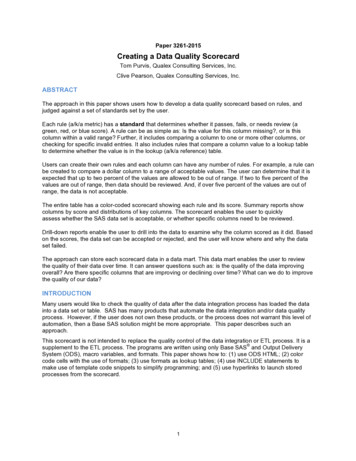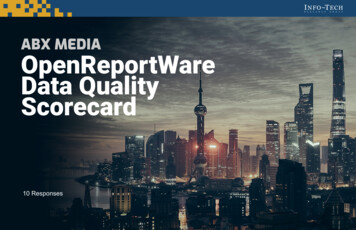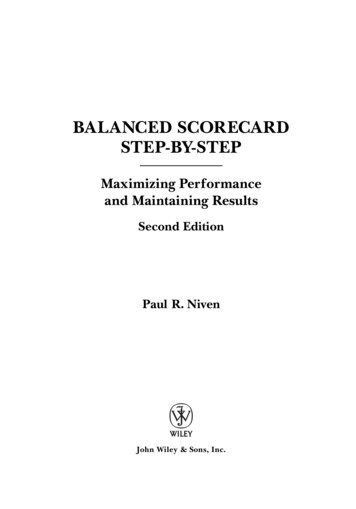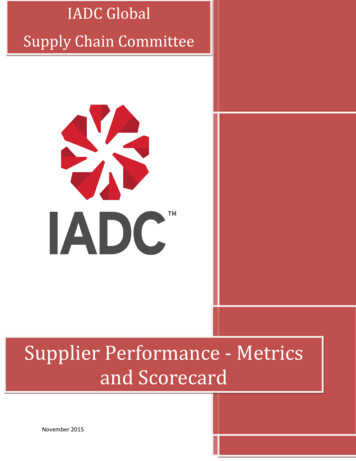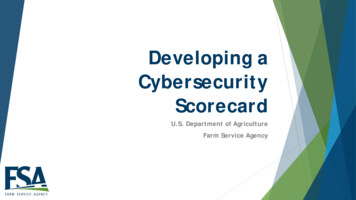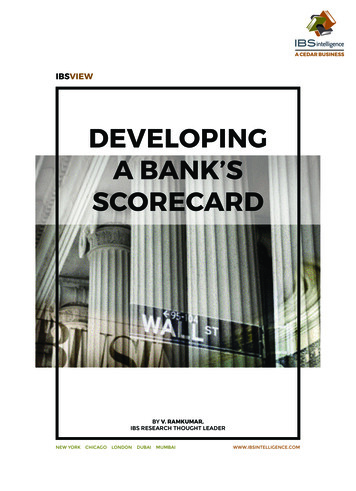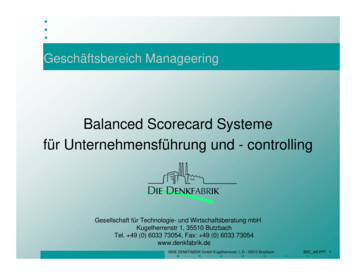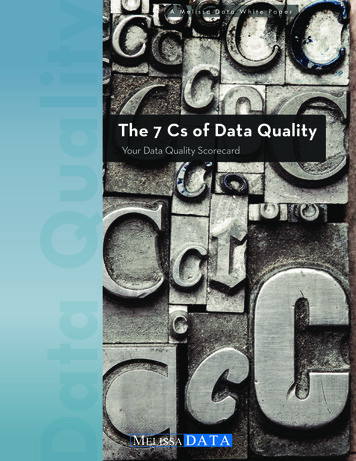
Transcription
A M e l i s s a D a t a W h i t e Pa p e rThe 7 Cs of Data QualityYour Data Quality Scorecard
2The 7 Cs of Data QualityAbout Melissa DataSince 1985, Melissa Data has been a leading provider of dataquality and address management solutions. Melissa Data’sdata quality software, Cloud services and data integrationcomponents verify, standardize, consolidate, enhance, andupdate U.S., Canadian, and global contact data for improvedcommunications and ROI. More than 5,000 companies relyon Melissa Data to gain and maintain a single, accurate andtrusted view of critical information assets.Web: melissadata.comTwitter: @melissadataYouTube: youtube.com/melissadatacorpFacebook: facebook.com/melissadataLinkedIn: linkedin.com/company/melissa-dataPhone: 1-800-MELISSA (635-4772)Copyright Melissa Data Corp. 2013. The following trademarks are owned by the United States Postal Service : USPS,CASS Certified, CASS, NCOALink, First-Class, Standard Mail, Postal Service, ZIP Code, P.O. Box.The 7 Cs of Data QualityIntroductionHow Do You Score on the 7 Cs of Data Quality?It seems like everyone today is talking about data quality. Why?Because clean data boosts the bottom line. Organizations withhealthy contact data save money on shipping and direct mailcosts; they formulate effective business strategies and marketingcampaigns based on accurate data; and their customers experiencehigh levels of satisfaction. But how many businesses understandhow to evaluate and correct issues related to data quality?In today’s data-driven marketplace, data quality issues can no longerbe downplayed or farmed out to the IT department. The health ofa company’s data impacts departments as varied as marketing,sales, accounting, and compliance.Our aim is to help business managers and executives, marketingprofessionals, and other non-technical personnel understand whatdata quality is, why it is important, and how they can quickly cleanup their company’s contact data.That’s why the 7 Cs of Data Quality are essential. We’ll look ateach one of the 7 Cs in detail, so you can absorb and apply thefundamental principles of data quality. The 7 Cs are:1. Certified Accuracy2. Confidence3. Cost-Savings4. Campaign Intelligence5. Consolidated6. Completed7. CompliantThe 7 Cs are the building blocks of data quality and they providea quick reference “scorecard” to help businesses--whether theyare large of small--assess the health of their organization’s contactdata. No matter whether your business is located in Europe, Asia, orNorth America, data quality is a must in the 21st Century.www.MelissaData.com3
4The 7 Cs of Data Quality1The 7 Cs of Data Quality2ertified AccuracyonfidenceHow Accurate is Your Data?It’s Time to Become E-ConfidentDo you know what percentage of your addresses are deliverable? In direct mailing costs alone, the averageU.S. company spends 180,000 a year on mail that never reaches its intended recipients. Consider thefact that 43 million Americans (one in six) move each year and 40% of this group does not file a change-ofaddress notice. Compounding this “data churn” is the reality that carrier routes change every day and eachmonth the U.S. Postal Service (USPS ) data file adds more than 100,000 changes.Identify theft costs business and financial institutions nearly 48 billion dollars a year, with an average lossof 5,000 per incident. Do you have confidence that a customer is who they say they are?How can you be confident that the information in your database is accurate and up-to-date? Businessescan employ a CASS Certified address verification solution that will validate, correct, and standardizecontact address data. The USPS offers vendors CASS certification, which is a designation that ensuresthe accuracy of address cleaning and matching software.E-Commerce is a critical part of doing business today, but many companies find that each year E-fraudnegatively impacts their E-commerce bottom line. And in today’s competitive global marketplace, you can’tafford to lose confidence in your online business activities.Verifying E-commerce data at the point-of-entry eliminates the inevitable consequences of bad contactdata: undeliverable/delayed shipments along with wasted postage and labor. Even if online shoppers arenot committing E-fraud, they can cost your company money by unknowingly entering incorrect data into aWeb contact form. FedEx and UPS charge 12 for address correction, and this can translate into thousandsof dollars wasted each year.Locate Customers Who Have MovedWhat does CASS stand for?It stands for CodingAccuracy SupportSystem. USPS listsCASS Certified software vendors likeMelissa Data on itswebsite.WE’VEMOVEDwww.MelissaData.comAnother important tool to ensure the accuracy of data isthe USPS NCOALink , database containing the names ofbusinesses, families, and individuals who have moved (andfiled a COA) within the last 48 months. Private companiesprovide access to NCOALink under the auspices of USPS licensing. Businesses simply upload their data via an FTPserver on a provider’s website. By checking a mailing listagainst the NCOALink file, companies fulfill USPS MoveUpdate requirements for First-Class and Standard Mail automation and presort discounts.Save money by preventing undeliverable-as-addressed mail.Data from the USPS indicates that nearly 20% of residencesand businesses change addresses each year. You cansave thousands of dollars annually by submitting your listsfor NCOALink processing, or other approved Move-Updatemethods from the Postal Service .I.D. VerificationIdentity authentication is a type ofdata quality that instantly checks anindividual’s self-entered information. Itutilizes powerful matching and retrievaltechnologies to compare incomingrecords against reference datasets—including USPS data, TELCO data,title information, and other publicand proprietary data—to determinethe accuracy and completeness. Theprocess essentially takes an historicsnapshot of each data componenton the record and identifies the mostup-to-date elements.5
6The 7 Cs of Data Quality3The 7 Cs of Data Quality4ost Savingsampaign IntelligenceHow Much is Bad Data Costing You?Successful Marketing Means Knowing Your CustomerU.S. businesses lose 600 billion a year because of bad data, withmore than 25% of that total due to customer data-entry errors.Save your company money by stopping bad data before it entersyour database in the first place.Looking to get a more accurate picture of your customers? Then itis time to employ a geocoding solution and assign precise latitudeand longitude coordinates to the addresses in your database.Doing so allows you to map where your customers live and work(helping you define and analyze the needs and preferences ofyour target population); focus direct mail campaigns in specificareas; and enrich your data by linking to associated demographicinformation such as census data, including income, housing, ethnicbackground, mortgages, and much more.How much money would you save each year if your companywas able to prevent returned shipments, correct undeliverableaddresses, merge/purge records, suppress bad addresses, trackdown customers who have moved, and guarantee marketingpieces reach their intended recipients? To answer such a question,you have to first take a hard look at what bad data is costing yourorganization right now.Keep Bad Data OutConsider the “1-10-100 Rule” which posits that it takes 1 to verifythe accuracy of a record at point-of-entry, 10 to clean it in batchform, and 100 per record if nothing is done (which includes theultimate costs associated with undeliverable shipments, lowcustomer retention, and inefficient CRM initiatives). Therefore, thebest ROI can be attained by employing a “data quality firewall” atpoint-of-entry to immediately verify the accuracy of information.If a potential customer, or your data-entry personnel, submitsinvalid contact information, a real-time data verification solution isapplied to prevent bad data from entering your database. In thisway, data coming in through an online shopping cart, Web form,or call center is verified and corrected before it even enters yourcompany’s CRM system. Correcting bad data before it enters thesystem means that you save money on returned shipments andwasted postage, all the while using employee time more efficientlyand improving customer satisfaction.www.MelissaData.comGeocoding technology helps businesses answer fundamentalquestions like: What is the geographic area we serve? Are our salesterritories and client clusters properly aligned? What are somemissed or overlooked areas where potential clients might exist?By geocoding client data, it becomes easier to recognize patternsand create new opportunities for businesses. Utilizing a geocodingsolution can help businesses strengthen customer relationships,improve profitability, and increase effectiveness.Targeting Customers with the Right MessageThe advent of social networking has allowed companies to connectlocation data to demographic and consumer lifestyle information.This development allows businesses to target users with ads thatare nearby and relevant to their consumer preferences. When youknow the precise location of a customer/prospect, and you can tiethat information with data about their retail shopping habits, forexample, you have a powerful opportunity for targeted marketing.7
8The 7 Cs of Data Quality5The 7 Cs of Data Quality6onsolidatedompletedUnify Your DataAppending Your DataOn average, 8-10% of the records in a typical database are duplicates. Unmatched records scatteredacross a company’s various databases prevent you from gaining a single, accurate view of customers,which ultimately impacts business decisions.Have you ever worked in a company that’s deployed a new CRMapplication with the idea that it will generate more leads, moresales, and better customer satisfaction, only to find the data is justnot good enough? For example, if the user does not have an emailaddress, then the record cannot be completed.One of the fundamentals of data quality is to search across the spectrum of a company’s data and mergeduplicate information into one “golden record” to gain valuable insight into user behavior and boost overallsales and marketing performance.Creating the Golden RecordThe process of producing a golden record (also known assurvivorship) is the ultimate goal of record consolidation. It is thefinal step in the record matching process and it involves choosingthe record with the best overall data quality. There are threecommon techniques in determining the surviving record: Most Recent - The most recent record can beconsidered eligible as the survivor. Most Frequent - Matching records containing the sameinformation are also an indication for correctness. Most Complete - Records with more values populatedfor each available field are also viable candidatesfor survivorship.Many companies today are going beyond “generic survivorship”techniques (as described above), and leveraging referencedata to gain a more sophisticated understanding of theactual contents of the data, and choose the record withthe best overall quality—the golden record. Theprocess also involves the verification of contactdata, including addresses, phone numbers,and email addresses to ensure the informationis valid and that no fees are incurred for correctingmailing and shipping addresses.www.MelissaData.comFewer email addresses means smaller email campaigns with lesslead generation and revenue potential. Many data quality serviceproviders can help alleviate this problem by filling in the gapsof your CRM database (appending additional information) withmissing phone numbers, postal addresses, and email addresses,ensuring your data is robust.The Power of Data Quality UpliftData Quality Uplift is a process that goes beyond discreet componentdata validation and updates a record to its most complete form. It isa cutting-edge process that cross-references the validity of the databy verifying that the customer record is deliverable, and that namescorrespond to address, email, and telephone data. It also ensuresthat the record is complete with all contact points appended.Data Quality Uplift enhances marketing campaigns and businessintelligence initiatives by completing customer records with missingdata like phone numbers, addresses, email addresses, andcompany names.9
10The 7 Cs of Data QualityThe 7 Cs of Data Quality7ompliantSatisfy Internal & External RegulationsIs the state of your data interfering with your ability to correctlyobserve external guidelines? Poor data leads to poor decisionswhich can undermine your customer relationships and credibility.In addition, with the increase in regulatory oversight, maintainingquality data that complies with internal and external regulations isessential.Here are just a few examples of regulations that require someform of data quality compliance: HIPAA 5010; the US Patriot Act;the Gramm-Leach-Biley Act; and the Fair and Accurate CreditTransactions (FACT) Act.The HIPAA ExampleHIPAA provides an excellent real-world example of the relationshipbetween data quality and compliance. In response to HIPAA, healthcare providers must comply with specific government regulationsregarding submission claims and billing procedures.One provision of HIPAA 5010 deals specifically with address contactdata. To be in compliance, providers must include a full 9-digit ZIPCodeTM for billing provider and service facility locations on all claimsubmissions. Another HIPAA rule prohibits the use of a PO BoxTMfor the billing provider address. If a health care providers’ data isin chaos and they cannot comply, they will have to pay the price.And while the specifics of compliance are different depending onthe industry and the regulation in question, the bottom line is thatcompliance issues intersect with contact data, forcing businessesto look long and hard at the state of their data.Take the Next Step So now that we’ve run through the 7 Cs of Data Quality, how would you rate your business? Are youa master data steward or is there room for improvement?Regardless of whether data quality is already a top priority at your company or you are just beginningto discover its key concepts, we’re certain you can utilize the 7 Cs of Data Quality and quickly makea significant contribution to your organization’s bottom line. Remember: the data quality investmentyou make now will pay dividends down the road in terms of saved time and money.Now that you’ve had your introduction to the 7 Cs, it’s time to take the next step and uploadyour data for a complimentary data quality audit from the professionals at Melissa Data. It’ssimple and quick:go to www.melissadata.com/scorefor your free assessment.www.MelissaData.com11
Many data quality service providers can help alleviate this problem by fi lling in the gaps of your CRM database (appending additional information) with missing phone numbers, postal addresses, and email addresses, ensuring your data is robust. The Power of Data Quality Uplift Data Qualit
